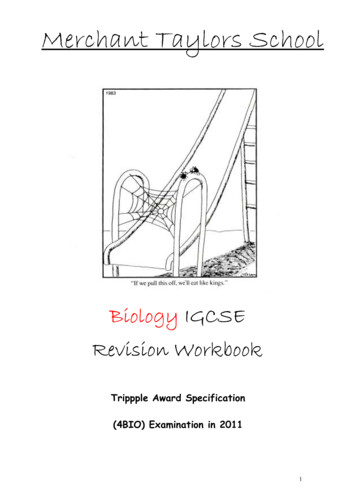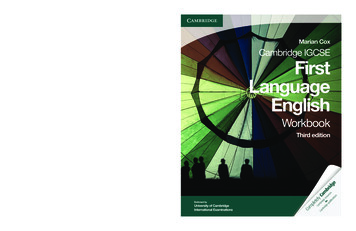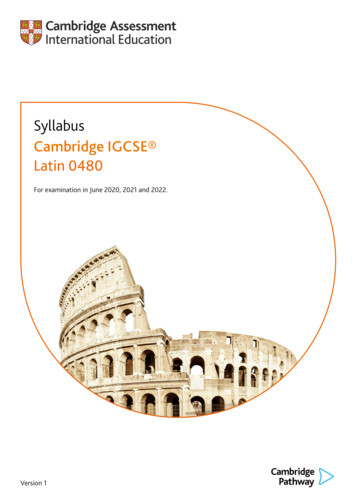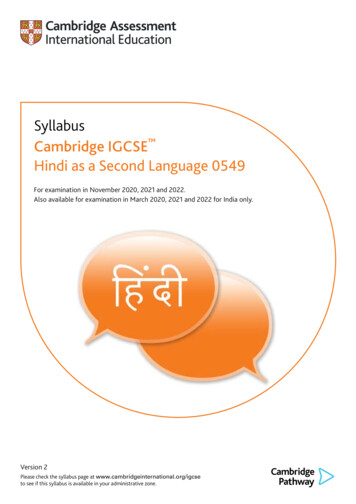
Transcription
Revision Checklist for IGCSEHistory 0470Guide for Students
Revision Checklist for IGCSE History 0470A Guide for StudentsHow to use this guideThe guide describes what you need to know about your IGCSE History examination. It will helpyou to plan your revision programme for the examination and will explain what the examiners arelooking for in the answers you write. It can also be used to help you to revise by using the tickboxes in Section 3, ‘What you should be able to’ to check what you know and which topic areasof History you have covered.The guide contains the following sections:Section 1 - How will you be tested?This section will give you information on the different examination papers that are available.Section 2 - What will you be tested on?This section describes the areas of knowledge, understanding and skills that the examiners willtest you on.Section 3 - What you should knowThis shows the syllabus content in a simple way so that you can check: which topics you need to know details about each topic in the syllabus how much of the syllabus you have coveredSection 4: AppendicesThis section covers other things you need to know such as: useful web sites important command words that Examiners use in the examination PapersNot all the information will be relevant to you. You will have to select what you need to cover inSections (1) and (3) by finding out from your teacher whether you are doing Coursework or thealternative Paper to coursework.
Section 1 - How will you be tested?1.1 About the examinations you will takeYou will sit three Papers: i.e. Paper 1 and Paper 2, and either Paper 3 (coursework) or Paper 4(alternative to coursework).Your teacher will be able to tell you whether you are doing coursework (Paper 3) or taking Paper4.If you are doing coursework, you will complete two assignments and just take Paper 1 and Paper2 in the examination. However, if you are not doing coursework, you will take three Papers in theexamination, i.e. Paper1, Paper 2 and Paper 4.1.2 About the written PapersThe table below gives you information about the written PapersHow long and howmany marks?What’s in the paper?Paper 12 hours (60 marks)You must answer a total of threequestions, two from Section A andone fromSection B.40%Paper 22 hours (50 marks)You must answer all of thequestions from either theNineteenth or Twentieth Centuryoption.33%PapernumberWhat’s the % ofthe total marks?Here is some more detail about each of the Papers:(i) Paper 1You have to answer three of the questions available, so take your time to choose your questionscarefully at the start of the examination.There will be two Sections – A and B.Section A (Core Content) will contain eight questions, four on the 19th century Core and four onthe 20th century Core. You must answer any two questions.Section B (Depth Studies) will contain two questions on each of the Depth Studies. You mustanswer one question.[Note: three questions will be set on Depth Study E, Southern Africa].Each question on Paper 1 will have three parts and will be based on stimulus material which willhelp your understanding of the questions but you do not have to use the source in your answer.The stimulus material may be a photograph, cartoon, written information, sketch map, diagram,graph table of information etc.You will be tested on your understanding of both the Core Content and Depth Study by showingin your answer the selection of relevant knowledge and your ability to write your response in anappropriate manner.
(ii) Paper 2This paper will have two options: a 19th-century topic and a 20th-century topic. Candidatesanswer the questions on one option.The topics will be prescribed by the Examination Board (CIE) each year and will be taken fromthe Core Content. Each option will include a collection of source material relating to theprescribed topic, and a series of questions based on the material.For the examination in 2009 the topics will be:19th century core: The modernisation of Japan (May/June examination) ORThe causes of the First World War (November examination)20th century core: German involvement in the Spanish Civil War (May/June 2009 examination)OR the decline and collapse of Soviet control over Eastern Europe (November 2009 examination)1.3 About the coursework/alternative written paperThe remaining examinations for IGCSE History are either in the form of coursework or anotherwritten paper, Paper 3 (two coursework assignments written in your own time) or the alternativeto coursework, Paper 4, which tests the same skills and knowledge as Papers 1 and 2 in a timedwritten examination. Your teacher will be able to tell you which Paper you will be entered for.PapernumberPaper 3How long and howmany marks?No fixed time(40 marks)Paper 41 hour(40 marks)What’s involved?You will complete twocoursework assignments ofabout 1500 words in total.Your teacher will design eachassignment which will bebased on any one or two ofthe Depth Studies you havebeen taught.You will answer onequestion only based upon one ofthe Depth Studies you havebeen taught.What’s the % of thetotal marks27%(you do eitherPaper 3 orPaper 4)27%(you do either Paper3 orPaper 4)Here is some more detail about these Papers:(i) Paper 3 (coursework)You will carry out two assignments during your History course, which will be assessed by yourteacher. One piece of work must target Objectives 1/2, and the other must target Objective 3 (seeSection 2 below). Each assignment will be worth up to 20 marks.
(ii) Paper 4 (alternative to coursework Paper)In this written paper you will answer one question on one of the Depth Studies. Each questionhas a part (a) and a part (b). Questions set in part (a) are designed to test your ability to usesource evaluation as in Paper 2 and questions set in part (b) are based on your ability to recallknowledge of the subject content being questioned as in Paper 1.
Section 2 - What will you be tested on?The examiners take account of the following skill areas in your examination Papers: knowledge (what you remember, select and use) understanding of some key concepts evaluation of sourcesThese skills are called assessment objectives. They are explained in the table below. Yourteacher will be able to give you more information about how each of these is tested in theexamination Papers.AssessmentobjectiveWhat the objectivemeansWhat you need to be able to do1:Recall ofKnowledgeRemembering andselecting relevant factsand applying theseappropriately in youranswersDemonstrating anunderstanding of keyhistorical ideas and thereasons why peoplemade decisions in thepastUnderstanding andassessing the meaning ofsources and using themas evidence of howpeople in the past madejudgements and acted theway they did.recall, select, organise and deploy knowledge of thesyllabus on ofsourcesdemonstrate an understanding of:(a) change and continuity, cause andconsequence, similarity and difference;(b) the motives, emotions, intentions andbeliefs of people in the past.comprehend, interpret, evaluate and use a range ofsources as evidence in their historical context.
Section 3 - What you need to knowThe tables below describe the topics you may be tested on in the examination. It is arranged intwo Options (19th and 20th Century) and eight Depth Studies with several topic areas within eachOption or Depth Study. Each topic area is divided up into sections, which contain the detail thatyou need to know.How to use the tablesYou can use the tables throughout your course to check the topic areas you have covered. Youcan also use it as a revision aid. When you think you have a good knowledge of a topic, you cantick the appropriate box in the checklist column.Test yourself as follows: cover up the details with a piece of paper try to remember the details using the prompts when you have remembered the details correctly, put a tick in the appropriate box. If you usea pencil to tick the boxes, you can retest yourself whenever you want by simply rubbing outthe ticks. If you are using the table as a checklist of which topics you have covered, you canput a tick in the topic column next to the appropriate point.The column headed ‘Comments’ can be used to: add further information about the details for each bullet point note relevant page numbers from your text book add learning aids e.g. BIG THREE AT VERSAILLES (Lloyd George, Clemenceau andWilson), ENABLING ACT (summary of details) highlight areas of difficulty/ things which you need to ask your teacher about.
Option A: 19th century, The Development of Modern Nation States, 1848-19141.1 Were theRevolutions of1848important?Topic outlineYou should be able to:Why were thereso manyrevolutions in1848?Describe the nature of revolutions in 1848 and theinfluence of liberalism and nationalism.Did therevolutions haveanything incommon?Why did most ofthe revolutionsfail?1.2 How wasItaly unified?Did therevolutionschange anything?Why was Italy notunified in 18481850?ChecklistDescribe the causes and events of revolutions inFrance, Italy, Germany and the Austrian Empire.As aboveDescribe the reasons for the failure of the revolutions.As aboveDescribe Austrian influence overnationalism and the role of Mazzini.Italy,ItalianHow importantwas Garibaldi'scontribution tounifying Italy?Describe the work of Garibaldi and the invasion of Sicilyand Naples and the creation of the Kingdom of Italy andthe completion of unification by 1870.Did Cavour helpor hinder theunification ofItaly?How important forother Europeancountries weremoves towardsItalianunification?Outline the events of 1848-9 and the work of VictorEmmanuel II and Cavour, Plombieres and the war withAustria in 1859.As aboveComments
Option A: 19th century, The Development of Modern Nation States, 1848-19141.3 How wasGermanyunified?Topic outlineWhy wasGermany notunified in 184850?You should be able to:Describe the nature of German nationalism, the work ofthe Zollverein, the 1848 revolution in Prussia and thesetting up and eventual failure of the FrankfurtParliament. Outline the re-establishment of Austrianinfluence in Germany by 1850.How didBismarck bringabout Austria'sdefeat of 1866?Describe the work of Bismarck as Prussian MinisterPresident, his foreign policy to 1871 includingSchleswig-Holstein, the Austro-Prussian War and itsconsequences.How didBismarck bringabout France'sdefeat of 1870?As aboveHow far wasBismarckresponsible forthe unification ofGermany?As aboveChecklistComments
Option A: 19th century, The Development of Modern Nation States, 1848-19141.4 Why wasthere a civilwar in theUnited States?Topic outlineHow far didslavery cause theCivil War?What was thesignificance ofLincoln's electionas President?Why was theNorth able to winthe war?Did the warchange anything?1.5 Howeffectively hadJapanmoderniseditself by 1914?You should be able to:Describe the causes and consequences of the AmericanCivil War, 1820-77: differences between North andSouth; slavery, slave states and free states;abolitionism; the 1860 election and secession of theSouthern states;Describe the reasons for the North's victory, the role ofLincoln; reconstruction. (Coverage of the events of thewar is not required except insofar as they help to explainthe North's victory.)As aboveChecklistCommentsChecklistCommentsAs aboveTopic outlineWhat was theimpact of Perry'smissions onJapan?Why did the MeijiRestorationoccur?You should be able to:Describe Perry's missions and the unequal treaties.Japan's relations with her neighbours to 1914.How westernisedwas Japan by1914?Was Japan aGreat Power by1914?As aboveDescribe the Meiji Restoration and modernisation.As above
Option A: 19th century, The Development of Modern Nation States, 1848-19141.6 Whatcaused theFirst WorldWar?Did the AllianceSystem makewar more likely orless likely?How far didcolonial problemscreate tensionsbetween theGreat Powers?Why wereproblems in theBalkans sodifficult for theGreat Powers tosolve?How did theassassination ofFranz Ferdinandlead to war?Describe the origins of the First World War, 1890-1914and the Alliance SystemOutline the colonial rivalries that existed at the timeOutline the developments in the Balkans between 1890and 1914 which led to tension in the areaDescribe the crisis of June-July 1914 and the outbreakof war.
Option B: The 20th century, International Relations since 19191.1 Were thePeace Treatiesof 1919-23fair?Topic outlineWhat were themotives and aimsof the Big Threeat Versailles?You should be able to:Describe the peace treaties of 1919-23: the roles ofindividuals such as Wilson, Clemenceau and LloydGeorge in the peacemaking processWhy did all thevictors not geteverything theywanted?As aboveWhat was theimpact of thepeace treaty onGermany up to1923?Describe the impact of the treaties on the defeatedcountriesCould the treatiesbe justified at thetime?Describe contemporary opinions about the treaties.ChecklistComments
Option B: The 20th century, International Relations since 19191.2 To whatextent was theLeague ofNations asuccess?Topic outlineHow successfulwas the Leaguein the 1920s?How far didweaknesses inthe League'sorganisationmake failureinevitable?You should be able to:Describe the strengths and weaknesses of the Leagueof Nations, including its structure and organisation,successes and failures in peacekeeping during the1920sAs aboveHow far did theDepression makethe work of theLeague moredifficult?Describe the impact of the World Depression on thework of the League after 1929How successfulwas the Leaguein the 1930s?Describe the failures of the League in the 1930s,including Manchuria and Abyssinia.ChecklistComments
Option B: The 20th century, International Relations since 19191.3 Why hadinternationalpeacecollapsed by1939?Topic outlineWhat were thelong-termconsequences ofthe peacetreaties of 191923?You should be able to:Describe the collapse of international order in the 1930s:the increasing militarism of Germany, Italy and Japan;What were theconsequences ofthe failures of theLeague in the1930s?As aboveHow far wasHitler'sforeignpolicy to blamefor the outbreakof war in 1939?Describe Hitler's foreign policy to 1939: the Saar,remilitarisation of the Rhineland, Anschluss with Austria,appeasement, crises over Czechoslovakia and Poland,the outbreak of war.Was the policy ofappeasementjustified?As aboveHow importantwas the NaziSoviet Pact?Why did Britainand Francedeclare war onGermany inSeptember1939?As aboveAs aboveChecklistComments
Option B: The 20th century, International Relations since 19191.4 Who wasto blame forthe Cold War?Topic outlineYou should be able to:Why did theUSA-USSRalliance begin tobreak down in1945?Describe the origins of the Cold War: the 1945 summitconferences and the breakdown of the USA-USSRalliance in 1945-6;How had theUSSR gainedcontrol of EasternEurope by 1948?Describe Soviet expansion into Eastern Europe to 1948,and American reactions to itHow did the USAreact to Sovietexpansionism?As aboveWhat were theconsequences ofthe BerlinBlockade?Describe the occupation of Germany and the BerlinBlockade.Who was themore to blame forstarting the ColdWar, the USA orthe USSR?All the aboveChecklistComments
Option B: The 20th century, International Relations since 19191.5 Howeffectively didthe USAcontain thespread ofCommunism?1.6 Howsecure wasthe USSR'scontrol overEasternEurope, 1948c.1989?Topic outlineYou should be able to:America andevents in Cuba,1959-62 andVietnam.Describe events of the Cold War: case studies ofAmerican reactions to the Cuban revolution, includingthe missile crisis and its aftermath.Describe American involvement in the Vietnam War.Why was thereopposition toSoviet control inHungary in 1956,Czechoslovakiain 1968, and howdid the USSRreact to thisopposition?How similar wereevents inHungary in 1956and inCzechoslovakiain 1968?Why was theBerlin Wall builtin 1961?What was thesignificance of'Solidarity' inPoland for thedecline of Sovietinfluence inEastern Europe?Describe Soviet power in Eastern Europe: resistance toSoviet power in Hungary (1956) and Czechoslovakia(1968)As aboveDescribe the background to the building of the BerlinWallDescribe the 'Solidarity' Movement in PolandChecklistComments
How far wasGorbachevpersonallyresponsible forthe collapse ofSoviet controlover EasternEurope?Describe the work of Gorbachev and the collapse of theSoviet Empire.
Option B: The 20th century, International Relations since 19191.7 Howeffective hasthe UnitedNationsOrganisationbeen?Topic outlineYou should be able to:What are thefunctions of theUNO?Describe the aims of the UNO, the organisation of theUNO, its agencies and their work.How far has theorganisation ofthe UNOhindered itseffectiveness?Case studies ofthe UNO inaction: theKorean War andthe Congo.Describe the implications of the growth of membership:admission of developing nations and China.Describe the work of the UNO in Korea (1950-3) and inthe Congo (1960-3).ChecklistComments
Depth Study A: Germany, 1918-451.1 Was theWeimarRepublicdoomed fromthe start?Topic outlineHow didGermany emergefrom defeat at theend of the FirstWorld War?You should be able to:Describe the Revolution of 1918 and the establishmentof the Republic.What was theimpact of theTreaty ofVersailles on theRepublic?Describe thereactions to it.To what extentdid the Republicrecover after1923?Describe the Weimar constitution, main politicaldivisions and the role of the army.Describe the political disorder, 1919-23; economiccrises and hyper-inflation and the occupation of theRuhr.What were theachievements ofthe Weimarperiod?Describe the achievements of the Stresemann era andthe cultural achievements of the Weimar nts
Depth Study A: Germany, 1918-451.2 Why wasHitler able todominateGermany by1934?Topic outlineWhat did the NaziParty stand for inthe 1920s?You should be able to:Describe the early years of the Nazi Party: Nazi ideasand methods, the Munich Putsch, the roles of Hitler andother Nazi leaders.Why did theNazis have littlesuccess before1930?As aboveWhy was Hitlerable to becomeChancellor by1933?Describe the impact of the Depression on Germany:political, economic and social crisis of 1930-3, reasonsfor the Nazis' rise to power,How did Hitlerconsolidate hispower in 1933-4?Describe how Hitler takes power, the Reichstag Fire andthe election of 1933.ChecklistComments
Depth Study A: Germany, 1918-451.3 (a) TheNazi regime:howeffectively didthe NaziscontrolGermany,1933-45?Topic outlineHow muchopposition wasthere to the Naziregime?You should be able to:Describe Nazi rule in Germany: the Enabling Act, theNight of the Long Knives, the death of Hindenburg,removal of opposition, methods of control andrepression, use of culture and the mass media.Describe Germany’s economic policy includingrearmament.How effectivelydid the Nazisdeal with theirpoliticalopponents?As aboveHow did theNazis use cultureand the massmedia to controlthe people?As aboveWhy did theNazis persecutemany groups inGerman society?As aboveWas NaziGermany atotalitarian state?As aboveChecklistComments
Depth Study A: Germany, 1918-451.3 (b) TheNazi regime:what was itlike to live inNaziGermany?Topic outlineHow did youngpeople react tothe Nazi regime?You should be able to:Describe the different experiences of Nazi rule: womenand young people, anti-Semitism, persecution ofminorities.How successfulwere Nazipolicies towardswomen and thefamily?As aboveDid most peoplein Germanybenefit from Nazirule?As aboveHow did thecoming of warchange life inNazi Germany?Describe the impact of the Second World War onGermany: conversion to war economy, the FinalSolution and the opposition to Nazi rule.ChecklistComments
Depth Study B: Russia, 1905-411.1 Why didthe Tsaristregimecollapse in1917?Topic outlineHow well did theTsarist regimedeal with thedifficulties ofruling Russia upto 1914?You should be able to:Describe the main features of Tsarist rule and Russiansociety before the First World War:How did the Tsarsurvive the 1905revolution?Describe the 1905 revolution and its aftermath, andattempts at reform.How far was theTsar weakenedby the First WorldWar?Describe the impact of the First World War on theRussian people.Why was therevolution ofMarch 1917successful?Describe the reasons for the successes of the Marchrevolution of 1917.ChecklistComments
Depth Study B: Russia, 1905-411.2 How didtheBolsheviksgain power,and how didtheyconsolidatetheir rule?Topic outlineHow effectivelydid theProvisionalGovernment ruleRussia in 1917?You should be able to:Describe the Provisional Government, the Soviets andthe growing power of revolutionary groups.Why were theBolsheviks ableto seize power inNovember 1917?Describe the reasons for the failure of the ProvisionalGovernment.Describe the Bolshevik seizure of power and the role ofLenin.Why did theBolsheviks winthe Civil War?Describe the main features of Bolshevik rule, the CivilWar, War Communism and the reasons for theBolshevik victory.How far was theNew EconomicPolicy asuccess?Describe the Kronstadt Rising and the establishment ofthe New Economic Policy.ChecklistComments
Depth Study B: Russia, 1905-411.3 How didStalin gainand hold on topower?Topic outlineWhy did Stalin,and not Trotsky,emerge asLenin'ssuccessor?You should be able to:Describe the circumstances of Lenin's death and thestruggle for power: reasons for Stalin's emergence asleader by 1928.Why did Stalinlaunch thePurges?Describe Stalin's dictatorship: use of terror, the Purges,propaganda and official culture.What methodsdid Stalin use tocontrol the SovietUnion?As aboveHow completewas Stalin'scontrol over theSoviet Union by1941?As aboveChecklistComments
Depth Study B: Russia, 1905-411.4 What wasthe impact ofStalin'seconomicpolicies?Topic outlineWhy did Stalinintroduce theFive-Year Plans?You should be able to:Describe Stalin's economic policies and their impact: themodernisation of Soviet industry, the Five-Year Plans,collectivisation in agriculture.Why did Stalinintroducecollectivisation?As aboveHow successfulwere Stalin'seconomicchanges?As aboveHow were theSoviet peopleaffected by thesechanges?Describe life in the Soviet Union: the differingexperiences of social groups, ethnic minorities andwomen.ChecklistComments
Depth Study C: The USA, 1919-411.1 How fardid the USeconomyboom in the1920s?Topic outlineOn what factorswas theeconomic boombased?You should be able to:Describe the expansion of the US economy during the1920sWhy did someindustriesprosper whileothers did not?Describe mass production in the car and consumerdurables industries, the fortunes of older industries, thedevelopment of credit and hire purchaseWhy didagriculture notshare in theprosperity?Describe the decline of agriculture during the 1920s.Did all Americansbenefit from theboom?Describe the weaknesses in the economy by the late1920s.ChecklistComments
Depth Study C: The USA, 1919-411.2 How fardid US societychange in the1920s?Topic outlineWhat were the‘Roaring 20s’?You should be able to:Describe society in the 1920s: the 'Roaring Twenties',film and other media, prohibition and gangsterism, racerelations, discrimination against black Americans, the KuKlux KlanHow widespreadwas intolerancein US society?As aboveWhy wasprohibitionintroduced, andthen laterrepealed?As aboveHow far did theroles of womenchange duringthe 1920s?Describe the changing roles of women in the 1920s.ChecklistComments
Depth Study C: The USA, 1919-411.3 What werethe causesandconsequencesof the WallStreet Crash?Topic outlineHow far wasspeculationresponsible forthe Wall StreetCrash?You should be able to:Describe the Wall Street Crash and its financial,economic and social effects. What was the reaction ofPresident Hoover to the Crash?What impact didthe Crash haveon the economy?As aboveWhat were thesocialconsequences ofthe Crash?As aboveWhy didRoosevelt win theelection of 1932?The Presidential election of 1932: Hoover's andRoosevelt's programmes.ChecklistComments
Depth Study C: The USA, 1919-411.4 Howsuccessfulwas the NewDeal?Topic outlineWhat was theNew Deal asintroduced in1933?You should be able to:Describe Roosevelt's inauguration and the 'HundredDays'.Describe the New Deal legislation, the 'alphabeticagencies' and their work, and the economic and socialchanges they caused.How far did thecharacter of theNew Deal changeafter 1933?As aboveWhy did the NewDeal encounteropposition?Describe the opposition to the New Deal: theRepublicans, the rich, business interests, the SupremeCourt, radical critics like Huey Long.Why didunemploymentpersist despitethe New Deal?Describe the strengths and weaknesses of the NewDeal programme in dealing with unemployment and theDepressionDid the fact thatthe New Deal didnot solveunemploymentmean that it wasa failure?As aboveChecklistComments
Depth Study D: China, 1945-c.19901.1 Why didChina becomea Communiststate in 1949?Topic outlineHow far did theSecond WorldWar weaken theNationalistgovernment?You should be able to:Describe the aftermath of the Second World War inChina: the outbreak of Civil War, reasons for the victoryof the Communists, the establishment of the People'sRepublic, 1949 and the nature of Chinese Communism.How far did theSecond WorldWar strengthenthe Communists?As aboveWhy was therewidespreadsupport for theCommunistsamongst thepeasants?As aboveWhy did theCommunists winthe Civil War?As aboveChecklistComments
Depth Study D: China, 1945-c.19901.2 How farhadCommunistrule changedChina by themid-1960s?Topic outlineWhat changes inagriculture didCommunist rulebring?You should be able to:Describe Communist rule in the 1950s and 1960s: agrarianreform from 1950, people's courts and the treatment of thelandlords, establishment of collectives and communes.What was theimpact of theCommunists' socialreforms?Describe social change: the role of women, health, education,propaganda and the destruction of traditional culture.How successfulwere the Five-YearPlans in increasingproduction?Describe industrial developments: the Five-Year Plans and theGreat Leap Forward.Did the Chinesepeople benefit fromCommunist rule?Describe social change: the role of women, health, education,propaganda and the destruction of traditional culture.ChecklistComments
Depth Study D: China, 1945-c.19901.3 What wasthe impact ofCommunistrule onChina'srelations withothercountries?Topic outlineWhat have beenChina's changingrelationships withneighbouringstates?You should be able to:Describe Chinese foreign policy: changing relationship with theUSSR; relations with other neighbouring countries, Tibet, India,Vietnam, Taiwan and Hong Kong.Why did China tryto improverelations with theUSA after 1970?Describe the establishment of closer relations with the USAfrom 1970.How far wasChinaestablished as asuperpower bythe time of Mao'sdeath?Describe Chinese foreign policy: changing relationship with theUSSR; relations with other neighbouring countries, Tibet, India,Vietnam, Taiwan and Hong Kong.How far haveChina's relationswith othercountriesimproved sinceMao's death?Describe the impact on China's relations with the rest of theworld of economic liberalisation since Mao's death.ChecklistComments
Depth Study D: China, 1945-c.19901.4 HasCommunismproduced a crueldictatorship inChina?Topic outlineWhy did Mao launchthe CulturalRevolution?You should be able to:Describe the Communist Party dictatorship:repression of political opposition, the HundredFlowers campaign, treatment of minority groupsWhat was the impact ofthe Cultural Revolutionon China?Describe the Cultural Revolution, the role and statusof MaoDid the death of Maolead to improvementsin the lives of Chinesepeople?Describe the power struggle after Mao's death andthe re-emergence of DengHow far did economicdevelopment in the1980s also producesocial and politicalchange?Describe the social and political consequences ofeconomic change in the 1980s and 90s.ChecklistComments
Depth Study E: Southern Africa in the Twentieth Century1.1 Why didwhites inSouth Africahave disputesamongthemselves,c.1880-1910?Topic outlineHow did thediscovery of goldheighten tensionsbetween theBritish and theBoers?You should be able to:Describe British relations with the Boer states:annexation of Transvaal, the war of 1880-1 and itsresults, growth of Afrikaner nationalism, the discovery ofgold and the rise of the mining industry, African migrantlabour, railway rivalriesWhat were theroles played byindividuals suchas Kruger andRhodes?Describe the roles of Kruger and RhodesWhat was theimpact of conflictand competitionbetween theBritish and theBoers on theAfrican peoplesof South Africa?Describe British annexations in South Africa and theirimpact on Africans.Why did warbreak out in1899, and withwhat results to1910?Describe the causes, course and consequences of theSecond Anglo-Boer War, 1899-1902 and the formationof the Union of South Africa.ChecklistComments
Depth Study E: Southern Africa in the Twentieth Century1.2 Howsuccessfulwas white rulein SouthAfrica, 191048?Topic outlineHow successfullydid the SouthAfrican economydevelop to 1948?You should be able to:Describe the development of South Africa under whiterule, 1910-48.What was thenature of whiterule in SouthAfrica?Describe the commercialisation of farming and the landissue: e.g. the Land Settlement Act (1912), the NativesLand Act (1913), the Natives Trust and Land Act (1936).Describe developments in the mining industry: workingconditions, labour disputes, the Gold Boom and itseffects.Describe state involvement in the economy andIndustrialisation and urbanisation.What was theimpact of whiterule on Africans?Describe the discriminatory and segregationist policiesof white rule in the inter-war period.How effectivelydid Africansorganisethemselvesagainst theeffects of whiterule?Describe the development of African nationalism andblack trade unions and political issues dividing the whiteminority.ChecklistComments
Depth Study E: Southern Africa in the Twen
20th century core: German involvement in the Spanish Civil War (May/June 2009 examination) OR the decline and collapse of Soviet control over Eastern Europe (November 2009 examination) 1.3 About the coursework/alternative written paper The remaining examinations for IGCSE History are either in the form of coursework or another










